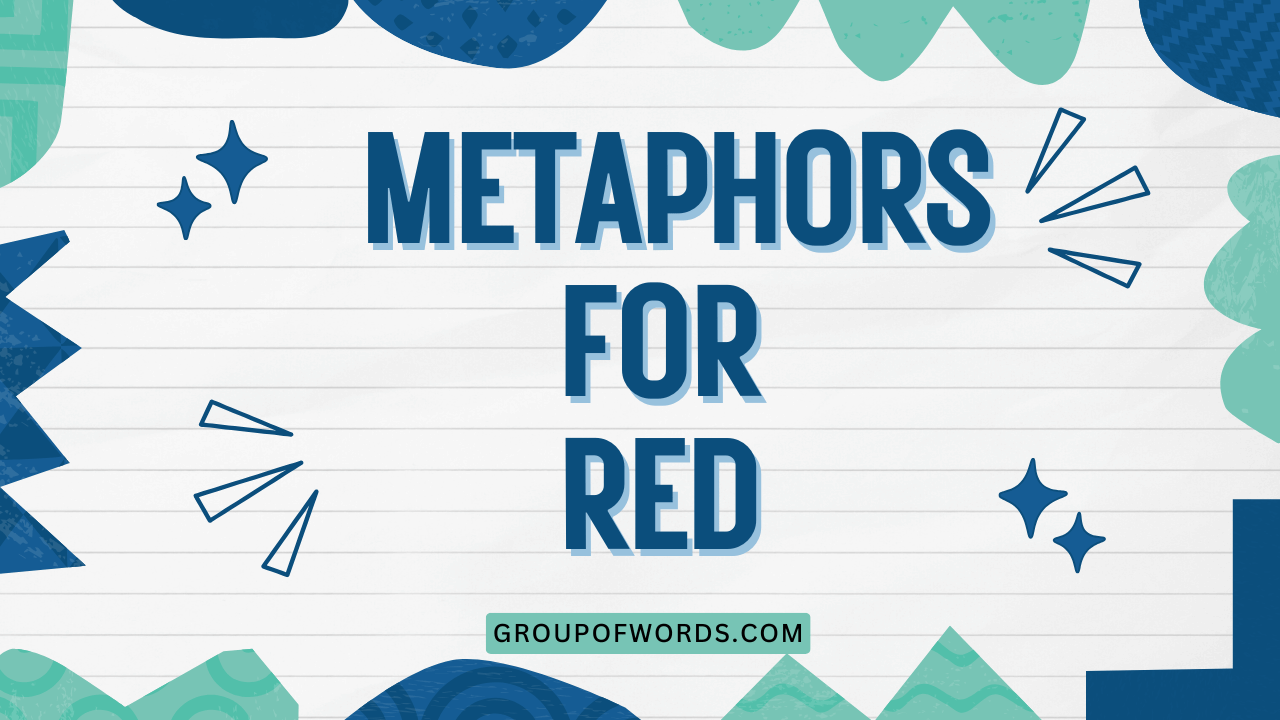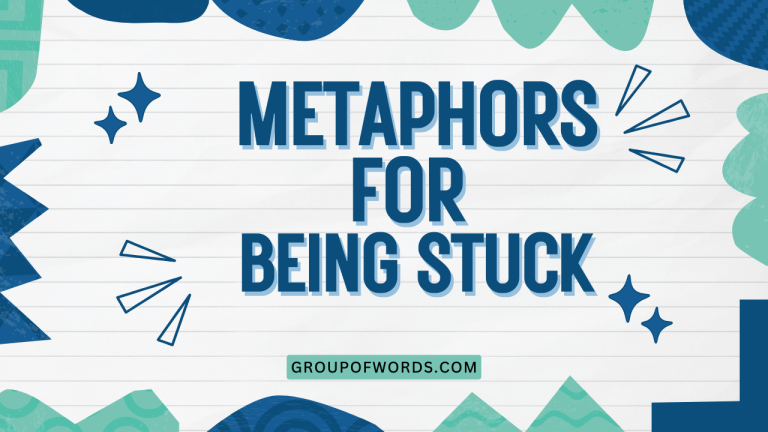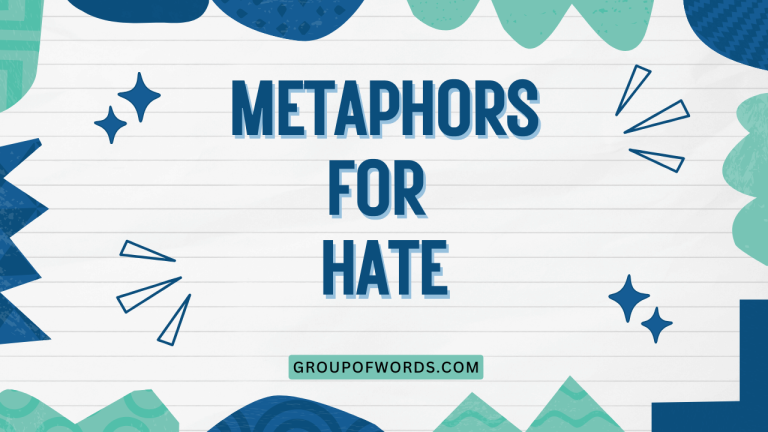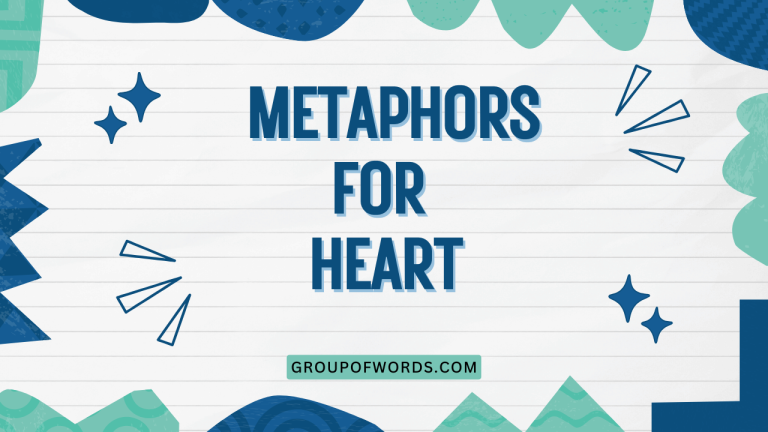Metaphors for Red: Exploring Figurative Language
Understanding metaphors is crucial for mastering English, as they add depth and color to language. This article focuses on metaphors for the color red, exploring how this vibrant hue is used figuratively to convey various emotions, ideas, and experiences.
Whether you’re an ESL student, a creative writer, or simply someone looking to enhance your vocabulary, this guide will provide you with a comprehensive understanding of red metaphors, their usage, and their impact on communication. By the end of this article, you’ll be able to recognize, interpret, and even create your own powerful metaphors using the color red.
Metaphors are more than just decorative language; they are fundamental to how we understand the world. In this article, we will dissect the various ways in which red is used metaphorically, providing numerous examples, usage rules, and practice exercises to solidify your understanding.
Let’s delve into the fiery world of red metaphors and discover how they enrich our language.
Table of Contents
- Definition of Metaphors for Red
- Structural Breakdown of Red Metaphors
- Types and Categories of Red Metaphors
- Examples of Red Metaphors
- Usage Rules for Red Metaphors
- Common Mistakes with Red Metaphors
- Practice Exercises
- Advanced Topics in Red Metaphors
- Frequently Asked Questions
- Conclusion
Definition of Metaphors for Red
A metaphor is a figure of speech that directly compares two unrelated things, stating that one thing *is* another, to highlight a shared quality or characteristic. Metaphors for red, specifically, use the color red as a symbol to represent abstract concepts, emotions, or situations. The effectiveness of a red metaphor relies on the common associations people have with the color – such as passion, anger, danger, or love. The function of these metaphors is to add vividness, emotional depth, and layers of meaning to language.
Red metaphors are classified as conceptual metaphors, where a basic concept (red) is used to understand a more complex or abstract idea. They are often used in literature, poetry, journalism, and everyday conversation to make language more engaging and impactful. For instance, saying “He saw red” doesn’t literally mean he saw the color red, but rather that he became extremely angry. This usage relies on the cultural association of red with intense emotions.
Structural Breakdown of Red Metaphors
The structure of a red metaphor typically involves two key elements: the tenor and the vehicle. The tenor is the subject or concept being described, while the vehicle is the color red (or a red-related image) used to convey that description. The connection between the tenor and the vehicle is the shared characteristic or association. Let’s break this down further:
- Tenor: The subject or concept being described (e.g., anger, passion, danger).
- Vehicle: The color red or a red-related image (e.g., blood, fire, a red flag).
- Ground: The shared characteristic or association between the tenor and the vehicle (e.g., intensity, heat, warning).
For example, in the metaphor “Her face was a crimson mask,” the tenor is her face, the vehicle is a crimson mask, and the ground is the association of crimson with embarrassment or anger. The structure can vary depending on the specific metaphor, but the core principle remains the same: using red to symbolize something else.
Understanding the structural components of a metaphor helps in both interpreting existing metaphors and creating new ones. By identifying the tenor, vehicle, and ground, you can better grasp the intended meaning and appreciate the figurative language used.
Types and Categories of Red Metaphors
Red metaphors can be categorized based on the specific concepts or emotions they represent. Here are some common categories:
Red as Emotion
Red is frequently used to represent intense emotions, such as love, passion, embarrassment, or anger. The association of red with the heart and blood contributes to its use in expressing feelings.
Examples include “red with embarrassment” or “a scarlet letter” representing shame.
Red as Danger
Red is universally recognized as a warning sign, and this association is reflected in metaphors related to danger. Phrases like “red flag” or “painted the town red” (originally implying violence) exemplify this usage.
The color’s visibility and historical association with fire and blood contribute to its symbolic representation of peril.
Red as Passion
Red symbolizes intense desire, love, and excitement. Metaphors in this category often evoke feelings of romance and energy.
Examples include “a red-hot romance” or “seeing red” in the context of intense infatuation. The color’s vibrancy and warmth contribute to its representation of passionate emotions.
Red as Anger
Red is a common metaphor for anger, often used to describe intense rage or fury. Phrases like “seeing red” or “a red mist” represent the overwhelming and consuming nature of anger.
The association of red with blood and violence reinforces its symbolic connection to anger.
Red as Alert
Red’s high visibility makes it an effective symbol for alerts and warnings. This is commonly seen in phrases like “code red” or “red alert,” which indicate immediate danger or a state of emergency.
The color’s ability to capture attention quickly contributes to its use in conveying urgency.
Examples of Red Metaphors
Below are several examples of red metaphors, categorized by the concepts they represent. Each table provides a range of examples to illustrate the diverse ways red is used figuratively in language.
Red Metaphors for Emotion
This table showcases how red is used to describe various emotional states, from embarrassment to intense love.
| Metaphor | Meaning | Context |
|---|---|---|
| Red with embarrassment | Extremely embarrassed or ashamed | She turned red with embarrassment after tripping on stage. |
| A scarlet letter | A symbol of shame or punishment | He felt like he was wearing a scarlet letter after his mistake. |
| Red-blooded | Passionate and full of life | He was a red-blooded adventurer, always seeking new thrills. |
| Rose-colored glasses | Seeing things in an overly optimistic way | She always looked at the world through rose-colored glasses. |
| As red as a beet | Extremely flushed or embarrassed | He became as red as a beet when she complimented him. |
| Paint the town red | Go out and have a wild, exciting time | They decided to paint the town red to celebrate their graduation. |
| Red tape | Bureaucratic obstacles and delays | The project was delayed due to excessive red tape. |
| Red herring | A diversion or distraction | The detective realized the clue was a red herring. |
| Red-letter day | A special or memorable day | Her wedding day was a red-letter day in her life. |
| Crimson tide | Overwhelming force or popularity | The crimson tide of support swept the candidate to victory. |
| Red roses | Symbol of love and romance | He gave her a bouquet of red roses on Valentine’s Day. |
| Red heart | Deep affection and care | She sent him a red heart emoji in her text message. |
| Crimson cheeks | Sign of shyness or excitement | Her crimson cheeks revealed her nervousness. |
| Ruby lips | Attractive and desirable lips | He was captivated by her ruby lips. |
| Red velvet | Luxury and indulgence | The red velvet curtains added a touch of elegance to the room. |
| Red carpet | Special treatment and prestige | The celebrity was given the red carpet treatment. |
| Red wine | Celebration and relaxation | They enjoyed a glass of red wine after a long day. |
| Red sunrise | New beginnings and hope | The red sunrise filled them with optimism. |
| Red sunset | Endings and reflection | The red sunset marked the end of a perfect day. |
| Red poppies | Remembrance and sacrifice | Red poppies were worn to honor the fallen soldiers. |
| Red coral | Beauty and fragility | The red coral was a stunning sight in the ocean. |
| Red berries | Abundance and nourishment | The forest was filled with red berries. |
Red Metaphors for Danger
This table illustrates how red is used to signify potential threats or hazardous situations.
| Metaphor | Meaning | Context |
|---|---|---|
| Red flag | A warning sign or indication of danger | His inconsistent behavior raised a red flag. |
| Code red | A state of emergency or high alert | The hospital went into code red after the explosion. |
| Red alert | An immediate warning of danger | The military issued a red alert due to the approaching enemy. |
| See red | To become extremely angry or enraged | He saw red when he heard the news. |
| Bloody mess | A chaotic or disastrous situation | The negotiations turned into a bloody mess. |
| Red zone | A dangerous or restricted area | Civilians were warned to stay out of the red zone. |
| Red light | A signal to stop or a warning against proceeding | The project received a red light due to budget constraints. |
| Scarlet fever | A widespread problem or epidemic | Corruption was like a scarlet fever spreading through the government. |
| Red ink | Financial losses or debt | The company was operating in the red ink for several quarters. |
| Red line | A limit or boundary that should not be crossed | He warned them not to cross the red line. |
| Blood red | Signifying extreme danger or violence | The sky turned blood red before the storm. |
| Cherry red | Indicates a hazardous situation or warning | The cherry red lights flashed, signaling an emergency. |
| Crimson warning | A vivid and urgent alert | The crimson warning on the screen demanded immediate action. |
| Red-hot poker | A dangerous and volatile situation | The political climate was like a red-hot poker. |
| Red tide | A harmful algal bloom | The red tide made swimming dangerous. |
| Red ant | A small but painful threat | The red ant bite was surprisingly painful. |
| Red spider | A subtle but dangerous pest | The red spider mites were destroying the plants. |
| Red alert system | A system indicating high risk | The city implemented a red alert system for air quality. |
| Red cross | Symbol of medical assistance in emergencies | The Red Cross provided aid to the victims. |
| Red button | A control for emergency actions | He pressed the red button to stop the machine. |
| Red card | Signifying expulsion or disqualification | The player received a red card for his foul. |
| Red flag law | Laws permitting temporary removal of firearms from individuals | The red flag law was controversial among gun owners. |
Red Metaphors for Passion
This table displays the use of red to represent intense feelings of love, desire, and excitement.
| Metaphor | Meaning | Context |
|---|---|---|
| Red-hot romance | A very passionate and intense love affair | They had a red-hot romance that everyone envied. |
| Burning with desire | Having a strong and intense longing | He was burning with desire for her. |
| Crimson heart | Symbol of deep love and affection | He gave her a crimson heart pendant. |
| Red lips | Signifying attractiveness and sensuality | Her red lips were captivating. |
| Red rose | Symbol of love and passion | He presented her with a single red rose. |
| Red fire | Intense passion and energy | Their love was like a red fire, burning brightly. |
| Red blooded | Passionate and vigorous | He was a red blooded man with a zest for life. |
| Red flame | A symbol of ardent love | She carried the red flame of their romance in her heart. |
| Red velvet | Represents luxury and sensual pleasure | The red velvet dress was incredibly alluring. |
| Red wine kiss | A passionate and memorable kiss | Their first kiss was a red wine kiss, full of flavor. |
| Red hot lover | An intensely passionate and desirable partner | She described him as a red hot lover. |
| Blazing red | An intense and overwhelming passion | His passion for her was blazing red. |
| Red satin | Symbolizing smooth and intense desire | The red satin sheets hinted at the passion within. |
| Red sunrise of love | New and intense beginnings in romance | Their meeting was the red sunrise of love. |
| Red ruby | Symbol of intense and precious love | He gifted her a red ruby ring to symbolize his love. |
| Red dance | A passionate and energetic performance | Their tango was a red dance of desire. |
| Red tango | Signifying intense and passionate connection | They danced a red tango, full of emotion. |
| Red ribbon | Symbol of unity in passionate causes | They wore red ribbons to show support. |
| Red fireflies | Fleeting moments of intense passion | Their moments together were like red fireflies. |
| Red dream | A passionate and intense vision | She had a red dream of their future together. |
| Red kiss | A symbol of intense and unforgettable affection | Their red kiss sealed their love. |
Red Metaphors for Anger
This table shows how the color red is used to express feelings of intense anger and rage.
| Metaphor | Meaning | Context |
|---|---|---|
| Seeing red | Becoming extremely angry | He started seeing red when he heard the insult. |
| Red mist | A state of extreme anger and loss of control | He was in a red mist and couldn’t think straight. |
| Red-faced with anger | Visibly angry and flushed | He was red-faced with anger after the argument. |
| Red rage | Intense, uncontrollable anger | His red rage was frightening to witness. |
| Boiling blood | Feeling intense anger | His blood was boiling when he saw the damage. |
| Crimson fury | Deep and intense anger | She unleashed her crimson fury on him. |
| Fiery red | Signifying a burning anger | His eyes were fiery red with anger. |
| Red storm | An outburst of anger | The meeting ended in a red storm of accusations. |
| Red-hot temper | A quick and intense anger | He was known for his red-hot temper. |
| Red vengeance | A desire for revenge fueled by anger | He sought red vengeance against those who wronged him. |
| Red glare | An angry and threatening look | He gave her a red glare that silenced her. |
| Red wall | A barrier of anger and hostility | He faced a red wall of resistance. |
| Red haze | A blurred state due to anger | He spoke through a red haze of fury. |
| Red flash | A sudden burst of anger | She saw a red flash of anger in his eyes. |
| Red zone of anger | A state where anger is at its peak | He was in the red zone of anger and couldn’t be reasoned with. |
| Red-faced fury | Expressing anger through visible redness | He erupted in red-faced fury. |
| Red pulse | The throbbing sensation of intense anger | He felt a red pulse of anger throbbing in his temples. |
| Red ember | A smoldering anger that can ignite | The red ember of resentment still burned within him. |
| Red tide of anger | An overwhelming and destructive anger | A red tide of anger swept over him. |
| Red volcano | A sudden and explosive outburst of anger | His anger erupted like a red volcano. |
| Red firestorm | A destructive and uncontrollable anger | A red firestorm of anger consumed him. |
Red Metaphors for Alert
This table provides examples of how red is used to signal warnings and states of emergency.
| Metaphor | Meaning | Context |
|---|---|---|
| Red alert | A state of high alert or emergency | The city was placed on red alert due to the storm. |
| Code red | A critical emergency situation | The hospital announced a code red for a mass casualty event. |
| Red flag warning | A warning of high fire danger | The national park issued a red flag warning. |
| Red light district | An area known for illicit activities | The red light district was heavily policed. |
| Red card | A penalty or warning in sports | The player received a red card and was ejected from the game. |
| Red notice | An international alert for wanted persons | Interpol issued a red notice for the fugitive. |
| Red zone | A dangerous or restricted area | The construction site was marked as a red zone. |
| Red beacon | A warning signal | The red beacon flashed, warning of danger. |
| Red marker | An indication of something needing attention | The report was covered in red markers indicating errors. |
| Red tape alert | An alert for excessive bureaucracy | The company issued a red tape alert on the new regulations. |
| Crimson alarm | A vivid and urgent warning | The crimson alarm blared through the building. |
| Red siren | A signal of immediate danger | The red siren signaled a tornado warning. |
| Red button alert | A critical action required immediately | The red button alert indicated a system failure. |
| Red emergency light | Signifying immediate need for assistance | The red emergency light illuminated the scene. |
| Red warning sign | A clear indication of potential danger | The red warning sign cautioned against entry. |
| Red danger zone | An area with high levels of risk | The area was marked as a red danger zone. |
| Red flashing light | Indicates urgent action is required | The red flashing light signaled an evacuation. |
| Red health alert | A public health emergency | The city issued a red health alert due to the outbreak. |
| Red fire alarm | A device to alert people to a fire | The red fire alarm was triggered by the smoke. |
| Red emergency beacon | A signal for help in a crisis | The red emergency beacon was activated after the crash. |
Usage Rules for Red Metaphors
When using red metaphors, it’s important to consider the context and audience to ensure effective communication. Here are some key usage rules:
- Clarity: Ensure the metaphor is clear and easily understandable. Avoid overly complex or obscure comparisons.
- Relevance: The connection between red and the concept being described should be logical and relevant.
- Consistency: Maintain consistency in your use of metaphors. Avoid mixing metaphors that create confusing or contradictory images.
- Cultural Sensitivity: Be aware of cultural differences in the interpretation of colors. Red may have different connotations in different cultures.
- Emotional Impact: Use red metaphors to evoke specific emotions or create a desired mood.
- Avoid Clichés: Try to avoid overused or cliché metaphors, such as “seeing red” (though knowing them is still useful). Strive for originality.
By following these rules, you can effectively use red metaphors to enhance your writing and communication. Always consider the impact your words will have on your audience.
Common Mistakes with Red Metaphors
Even experienced writers can make mistakes with metaphors. Here are some common errors to avoid when using red metaphors:
| Mistake | Incorrect Example | Correct Example | Explanation |
|---|---|---|---|
| Mixed Metaphors | “He was a red flag sailing through a sea of anger.” | “He was a red flag in the relationship.” or “He was consumed by a sea of anger.” | Mixing unrelated images creates confusion. |
| Unclear Connection | “The book was red with ideas.” | “The book was filled with revolutionary ideas.” | The connection between “red” and “ideas” is not immediately clear. |
| Overuse | “The red sun set on their red love, turning the sky red with passion.” | “The setting sun mirrored their passionate love.” | Overusing the same metaphor weakens its impact. |
| Cultural Misunderstanding | (Assuming red always means danger in every culture) | (Researching the cultural significance of red in the specific context) | Red can symbolize different things in different cultures. |
| Literal Interpretation | “He literally saw red paint on the wall when he got angry.” | “He saw red when he got the news.” | Metaphors should not be interpreted literally. |
Understanding these common mistakes will help you use red metaphors more effectively and avoid creating confusing or inappropriate imagery.
Practice Exercises
Test your understanding of red metaphors with these practice exercises. Identify the meaning of the red metaphor in each sentence.
| Question | Answer |
|---|---|
| 1. The politician’s speech was full of red meat for his base. | Appealing to the core beliefs and desires of his supporters. |
| 2. She waved a red flag when she questioned the company’s ethics. | Raised a warning sign about a potential problem. |
| 3. The project was drowning in red tape. | Suffering from excessive bureaucracy and delays. |
| 4. He painted the town red to celebrate his promotion. | Went out to have a wild, exciting time. |
| 5. The detective realized the suspect was a red herring. | A diversion or distraction from the real culprit. |
| 6. Her wedding day was a red-letter day in her life. | A special or memorable day. |
| 7. He was red-blooded and ready for adventure. | Passionate and full of life. |
| 8. The company was operating in the red ink. | Experiencing financial losses or debt. |
| 9. The protesters drew a red line that the government couldn’t cross. | A limit or boundary that should not be crossed. |
| 10. The news of the scandal left his face as red as a beet. | Extremely flushed or embarrassed. |
Now, create your own sentences using the following red metaphors:
| Metaphor | Your Sentence |
|---|---|
| 1. See red | [Your Answer Here] |
| 2. Red hot | [Your Answer Here] |
| 3. Crimson tide | [Your Answer Here] |
| 4. Red alert | [Your Answer Here] |
| 5. Red zone | [Your Answer Here] |
| 6. Red flag | [Your Answer Here] |
| 7. Red tape | [Your Answer Here] |
| 8. Red herring | [Your Answer Here] |
| 9. Red-letter day | [Your Answer Here] |
| 10. Paint the town red | [Your Answer Here] |
Example Answers:
- I saw red when I found out someone had vandalized my car.
- The new restaurant is red hot, everyone wants to try it.
- The crimson tide of support for the candidate was overwhelming.
- After the earthquake, the city was placed on red alert.
- The area near the nuclear plant is a red zone.
- His constant lateness was a red flag for his employer.
- We couldn’t get the permit because of all the red tape.
- The misleading advertisement was a red herring designed to distract consumers.
- Graduation day was a red-letter day in her life.
- They decided to paint the town red after winning the championship.
Advanced Topics in Red Metaphors
For advanced learners, exploring the nuances of red metaphors can lead to a deeper understanding of figurative language. Consider the following advanced topics:
- Historical Context: Research the historical origins of specific red metaphors and how their meanings have evolved over time.
- Cultural Variations: Investigate how the symbolism of red differs across various cultures and languages.
- Literary Analysis: Analyze how famous authors use red metaphors in their works to create specific effects.
- Psychological Impact: Explore the psychological effects of red metaphors on readers and listeners.
- Creating Original Metaphors: Develop your ability to create original and impactful red metaphors that convey complex ideas.
By delving into these advanced topics, you can further refine your understanding and appreciation of red metaphors.
Frequently Asked Questions
Here are some frequently asked questions about metaphors for red:
- What is the difference between a metaphor and a simile?
A metaphor states that one thing *is* another, while a simile uses “like” or “as” to make a comparison. For example, “He is a lion” (metaphor) versus “He is brave as a lion” (simile). - Why is red often associated with anger?
The association of red with anger likely stems from the physiological response to anger, which can cause the face to flush and blood pressure to rise. Additionally, red is often associated with violence and aggression, further reinforcing this connection. - How can I improve my use of red metaphors?
Practice reading and analyzing examples of red metaphors, paying attention to their context and intended meaning. Experiment with creating your own metaphors and seek feedback from others. - Are red metaphors universal?
While some associations with red, such as danger, are relatively universal, others can vary significantly across cultures. It’s important to be aware of these differences when using red metaphors in cross-cultural communication. - What are some alternatives to “seeing red”?
Alternatives include “losing it,” “flying off the handle,” “going ballistic,” or “exploding with anger.” - How do I avoid clichés when using red metaphors?
Try to think outside the box and come up with fresh and original comparisons. Consider using less common associations with red, or combining red with other sensory details to create a more vivid image. - Can red metaphors be used in formal writing?
Yes, but use them judiciously. In formal writing, metaphors should be used to enhance clarity and impact, not to distract from the main point. Choose metaphors that are appropriate for the tone and audience of your writing. - What is the role of context in understanding red metaphors?
Context is crucial for understanding red metaphors. The meaning of a metaphor can change depending on the surrounding words, the situation, and the cultural background of the audience. Always consider the context when interpreting or using red metaphors.
Conclusion
Metaphors for red add vibrancy and depth to the English language, allowing us to express complex emotions and ideas in a vivid and memorable way. By understanding the structure, types, and usage rules of red metaphors, you can enhance your communication skills and appreciate the richness of figurative language.
Remember to consider the context, audience, and cultural implications when using these metaphors to ensure effective and impactful communication.
Continue to practice and explore the world of red metaphors, and you’ll find yourself becoming more adept at recognizing, interpreting, and creating your own powerful figurative language. Embrace the creativity and expressiveness that metaphors offer, and you’ll unlock new dimensions in your understanding and use
of language.






